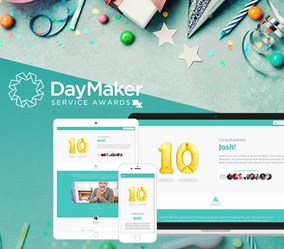Help! My service award program has fallen and it can't get up.
May 01, 2019
10 ways to get your anniversary program standing tall again
Scroll Down
A frequent concern many organizations have is whether their service award program is relevant or not. While often considered a corporate “tradition”, service award programs can also be viewed as a relic of the past – an institutional dinosaur offering lapel pins, charms, pens and watches sporting the company logo, items few employees find appealing or useful.
This is a legitimate concern. Operating a service award program uses valuable resources that perhaps could be applied in other ways to engage and recognize associates. However, before you make the decision to sunset your program, first consider these ten ways to refresh, revitalize and enhance your program to make it appealing, fun and relevant for your employees.
1. Evaluate your award choices.
Reach out to your employees and ask how they would like to celebrate service anniversaries. Use surveys or focus groups to discover what merchandise awards or experiences appeal to them. Many companies are offering a broad selection of awards including lifestyle merchandise, eco-friendly items, commissioned art, branded apparel, concierge services, points as part of a multi-initiative platform and even charitable donations.
Make it an annual or bi-yearly task to speak with employees and find out what they want so you are continuously keeping your selections interesting and up-to-date.
2. Get social.
We are a society that increasingly loves to share our achievements using social media like Facebook and Twitter. Consider aligning with a service award supplier who can help you integrate internal and external social media strategies into your program. When hundreds of managers, co-workers, family and friends know about the anniversary, the celebration becomes an enhanced experience for the employee.
3. Decide if branding is really necessary.
Chances are that your current program includes traditional items such as jewelry, clocks, key fobs, pens and money clips that include your company logo. While the logo does establish a link between the item and the reason for receiving it, it can add considerable cost to the award without adding any value. In fact, some employees may choose NOT to wear or use the item
because the logo is on it.
Again, ask your employees if they find the logo to be appealing or a deal-breaker. If employees don’t like the logo embellishment, get rid of it and use your additional budget to offer more desirable awards.
4. Empower your entire management structure.
Ongoing support and active participation from all managers can have a profound impact on your service award program. The employee experience is magnified when managers play a significant part in celebrating the anniversary.
To empower your managers, be sure to communicate your expectations on what you want their role to be. Train them on how to create a positive celebration. Measure their involvement with simple surveys and employee feedback. And, reinforce great manager participation by recognizing their efforts and asking them to mentor others.
5. Make sure your technology is up-to-date.
The web platform you set up just a few years ago is likely almost obsolete. Your service award site needs to be updated regularly with user-friendly interfaces, new content and be scalable to reflect your updated award selections.
Your platform also needs to seamlessly function on desktops, laptops, tablets and smartphones. Anyone who has tried to access a traditional site from a mobile device knows that it can be nearly impossible to navigate. You want your entire award experience to be positive and easy.
Your platform should also be able to provide you with reports on-demand. To ensure that you are maximizing your recognition investment, insist that your vendor deliver the exact metrics you need, when you need them.
6. Remember your international employees.
More and more organizations have an international presence. Off-shore employees deserve to be included in your service award program, but may have different needs and cultural expectations. When selecting your awards supplier, be sure they have the capabilities to provide in-country awards selection and delivery, multi-lingual capable web platforms and have
a deep understanding of the local culture.
Giving the “wrong” item can do more harm than good. Did you know that leather items are taboo in Hindu countries where the cow is sacred? A compass is a valued gift in Muslim countries because it makes finding Mecca easier for prayers, while locally-produced items are sometimes considered too “common” to be used as awards in many countries – such as silver
in Mexico and wine in France.
7. Analyze employee tenure data.
Traditionally service awards are given at five year intervals. This makes sense when you have a long-term employee base. That’s seldom the case in most companies today. Statistics show that the average American worker stays with any one company for an average of just over three years – not long enough to even earn the first five year award!
If this is what your data reveals, consider offering awards at the one and three year levels. Some organizations such as retailers and fast food restaurants even offer a token award at 90 days tenure followed up with a six month award.
These awards do not need to be expensive. Rather they should reflect your appreciation for the service provided to date.
8. Take "non-connected" employees into consideration.
If your employees don’t have work-time access to the Internet, you may need to explore other ways for them to select and order their awards. While most Americans are plugged in at work or home, some are not. If you have unconnected employees, offer opportunities to access the website from kiosks in lunch rooms, break rooms or computer hubs.
9. Reconsider precious metal and gemstone items.
A growing trend in many organizations is incorporating numerous employee initiatives into a single employee recognition strategic platform. Under this structure, employees earn a common medium such as points for a wide range of activities including peer-to-peer recognition, manager discretionary awards, safety, wellness, productivity, cost-savings, learning and other measurable goal programs.
When you partner with other initiatives you can cost share overhead expenses such as your web platform, data analysis, administration and communications. This gives everyone involved more resources for enhanced awards, better targeted communications and a superior experience for employees.
It also gives employees opportunities to accrue points and redeem for a larger value award that they find more desirable, but wouldn’t fit into any single initiative’s budget.
10. Reconsider precious metal and gemstone items.
The precious metal and gemstone market is volatile and unpredictable. In 2003, gold averaged $300 per ounce. In late 2012 it was near $1800 an ounce and has been around $1300 to $1500 an ounce recently. This makes budget management extremely difficult for you and your award suppliers. Your suppliers will price on the high side to protect themselves, which doesn’t result in the best value for you.
Look at the redemption details of your program. If these items are not popular choices, or if you don’t see employees wearing/using them, consider removing them from your program. Some organizations have discovered that employees were selecting the gold items and then selling them to a scrap gold buyer. That, of course, is not at all what the organization intended
when they selected gold items for their service award program.
Change is good
Employees may not want to wear a company-logoed lapel pin or charm anymore, but that doesn’t mean that they don’t want to be recognized and rewarded for their loyalty and service. By using these ten tips, you can get your service award program up off the ground and back to being an effective recognition and employee engagement tool.













